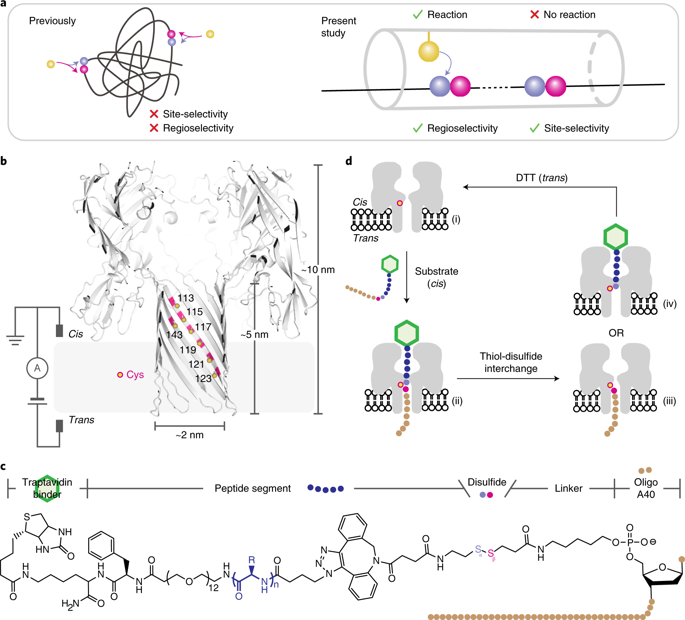当前位置:
X-MOL 学术
›
Nat. Nanotechnol.
›
论文详情
Our official English website, www.x-mol.net, welcomes your feedback! (Note: you will need to create a separate account there.)
Catalytic site-selective substrate processing within a tubular nanoreactor.
Nature Nanotechnology ( IF 38.3 ) Pub Date : 2019-11-18 , DOI: 10.1038/s41565-019-0579-7 Yujia Qing 1 , Hiroko Tamagaki-Asahina 1, 2 , Sandra A Ionescu 1 , Mira D Liu 1, 3, 4 , Hagan Bayley 1
Nature Nanotechnology ( IF 38.3 ) Pub Date : 2019-11-18 , DOI: 10.1038/s41565-019-0579-7 Yujia Qing 1 , Hiroko Tamagaki-Asahina 1, 2 , Sandra A Ionescu 1 , Mira D Liu 1, 3, 4 , Hagan Bayley 1
Affiliation

|
Chemists have long sought the ability to modify molecules precisely when presented with several sites of similar reactivity. We reasoned that the confinement of substrates within nanostructures might permit site-selective reactions unachievable in bulk solution, even with sophisticated reagents. In particular, the stretching and alignment of polymers within nanotubes might allow site-specific cleavage or modification. To explore this proposition, macromolecular disulfide substrates were elongated within members of a collection of tubular protein nanoreactors, which contained cysteine residues positioned at different locations along the length of each tube. For each nanoreactor, we defined the reactive location by using a set of polymer substrates (site-selectivity) and which of the two sulfur atoms was attacked (regioselectivity), and found that disulfide interchange occurs with atomic precision. Our strategy has potential for the selective processing of a wide variety of biomacromolecules, and the chemistry and substrates might be generalized yet further by using alternative nanotubes.
中文翻译:

管状纳米反应器内的催化位点选择性底物处理。
化学家长期以来一直寻求能够在出现多个具有相似反应性的位点时精确修饰分子的能力。我们认为,即使使用复杂的试剂,纳米结构内底物的限制也可能允许在本体溶液中无法实现的位点选择反应。特别地,纳米管内的聚合物的拉伸和排列可以允许位点特异性裂解或修饰。为了探索这一命题,将大分子二硫化物底物在管状蛋白质纳米反应器集合的成员中拉长,该管状蛋白质纳米反应器包含沿每个试管长度位于不同位置的半胱氨酸残基。对于每个纳米反应器,我们通过使用一组聚合物底物(位点选择性)和两个硫原子中的哪个被攻击(区域选择性)定义了反应位置,并且发现二硫键交换发生在原子精度上。我们的策略具有对多种生物大分子进行选择性处理的潜力,并且通过使用其他纳米管,化学和底物可能会进一步推广。
更新日期:2019-11-18
中文翻译:

管状纳米反应器内的催化位点选择性底物处理。
化学家长期以来一直寻求能够在出现多个具有相似反应性的位点时精确修饰分子的能力。我们认为,即使使用复杂的试剂,纳米结构内底物的限制也可能允许在本体溶液中无法实现的位点选择反应。特别地,纳米管内的聚合物的拉伸和排列可以允许位点特异性裂解或修饰。为了探索这一命题,将大分子二硫化物底物在管状蛋白质纳米反应器集合的成员中拉长,该管状蛋白质纳米反应器包含沿每个试管长度位于不同位置的半胱氨酸残基。对于每个纳米反应器,我们通过使用一组聚合物底物(位点选择性)和两个硫原子中的哪个被攻击(区域选择性)定义了反应位置,并且发现二硫键交换发生在原子精度上。我们的策略具有对多种生物大分子进行选择性处理的潜力,并且通过使用其他纳米管,化学和底物可能会进一步推广。


























 京公网安备 11010802027423号
京公网安备 11010802027423号